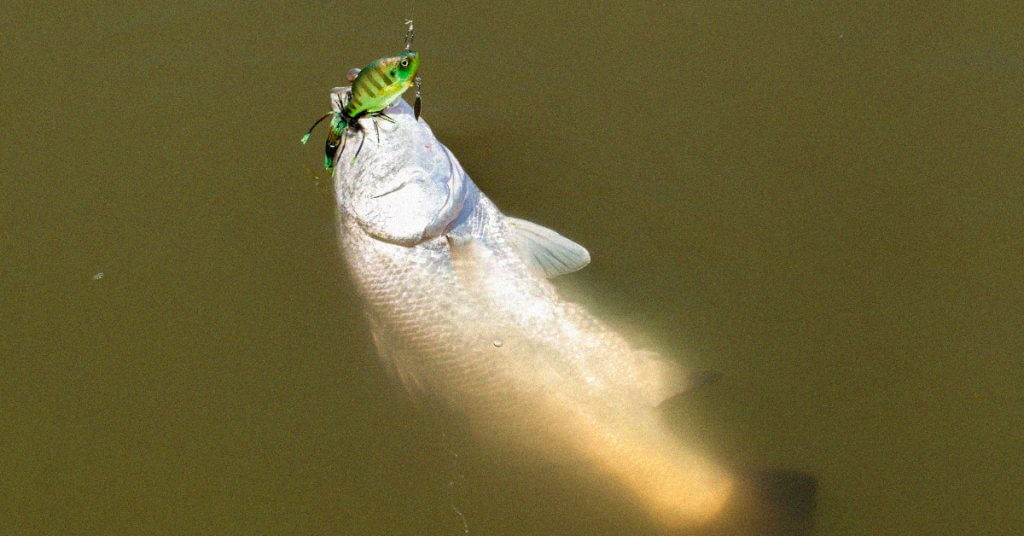Effective fishing starts with choosing the right lure for the conditions. Each type has a specific purpose, from deep-water jigging to topwater action. Understanding what to use and when is the key to success.
Last Updated: December 2nd, 2024
Video Overview
Anglers.com Wesley Littlefield runs through the most common types of fishing lures and when to use them in this YouTube video.
Fishing Lure Types Chart

Jigs

Miss more fish than you hook when fishing around heavy cover? Most anglers struggle to reach bass in their prime ambush spots, burning through expensive lures that snag or can’t trigger strikes in thick cover. The secret is matching the right presentation to these challenging conditions.
That’s where hair jigs really shine. Made with a lead head, single hook, and rubber skirt (usually with a weed guard), these versatile lures perfectly mimic the crawfish and bluegill that big bass can’t resist. I’ve found they’re especially deadly for bottom-feeding fish, thanks to their fluttery, lifelike action.
Alternatively, you can also swim your jig. Vary the cadence on your retrieve, letting the lure bounce and jerk as you move through the middle of the water column.
These types of fishing baits make them ideal for dense vegetation, but it’s easy for the large, heavy fish to get snarled up in the weeds when you’re reeling in.
To overcome this issue, you’ll need a sturdy rod with a flexible tip to dance your jig and haul your catch through any obstacles.
In cold weather, fish prefer hiding out in rock cover, weeds underwater timber, where they can hunt smaller, less-mobile prey while conserving their energy.
Cast out towards coves or grassy patches, wait for your line to slack, and slowly bounce the jig along the bottom.
A jig’s movements will catch the attention of any lurking aquatic apex predators but likely won’t attract skittish panfish looking for smaller targets.
Tube Baits
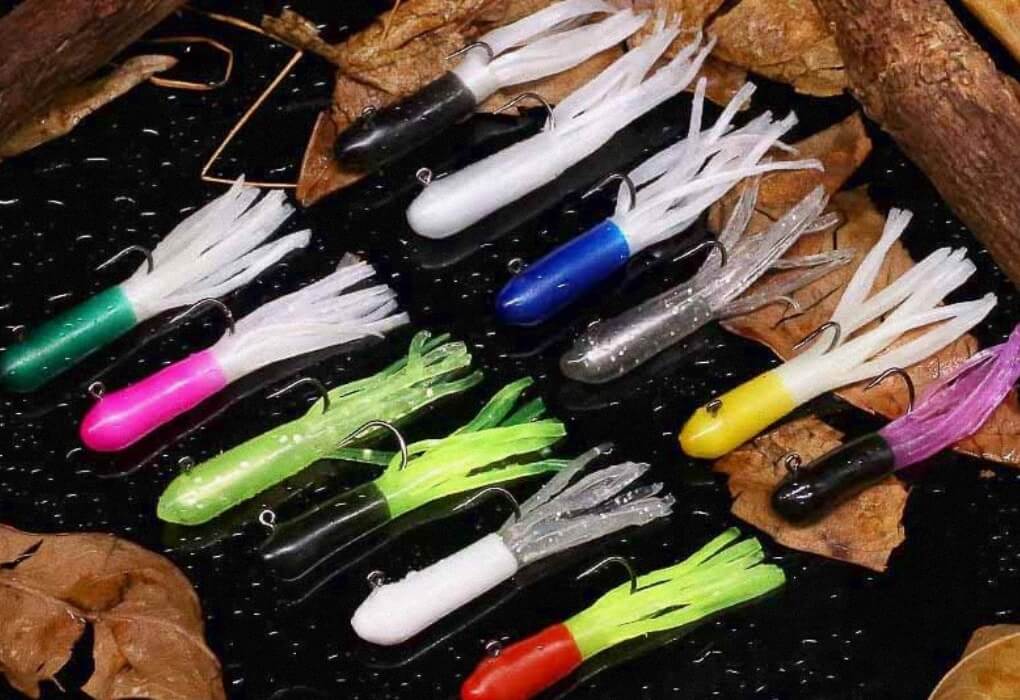
Are you frustrated by fish that follow your lure but won’t commit? Many anglers overlook one of the most versatile solutions hiding in plain sight. The challenge isn’t just getting bites – it’s presenting something that looks natural enough to fool even pressured fish.
That’s why I always keep tube baits in my arsenal. These simple soft plastics might look basic, but their hollow head and tentacled design creates one of the most natural presentations you’ll find. The trapped air in the head makes them sink with a tantalizing wobble that perfectly mimics a dying shad.
For shallow waters, add a little styrofoam into the hollow head. This will maintain its buoyancy while you twitch the line, drawing strikes from fish who like to snatch insects from the surface of the water.
Deep water offers even more options. You can get a good sink by inserting a jig head into the hollow body, then casting past the school.
As the air escapes, the tube bait will spiral beautifully in the water, drawing in predatory fish on the lookout for forage while still obtaining the necessary depth when angling for crappie, walleye, or other saltwater target fish.
After infiltrating a school, use a pump and reel technique to keep the motion natural.
Tube baits offer plenty of room for you to finesse through any kind of cover, depending on where the fish are schooling.
They do particularly well off of bluffs or underwater rock walls, where you can let a jig-weighted tube bounce down the layers.
As it falls, the tentacles will dance around as it spirals through the water, creating a more natural swimming pattern.
The heads are also perfect for adding cotton balls soaked in attractant. As the tubes dance through the water, they’ll leave a scent trail that makes striking in murky water easier and less reliant on flashy movements or color.
Soft Plastics
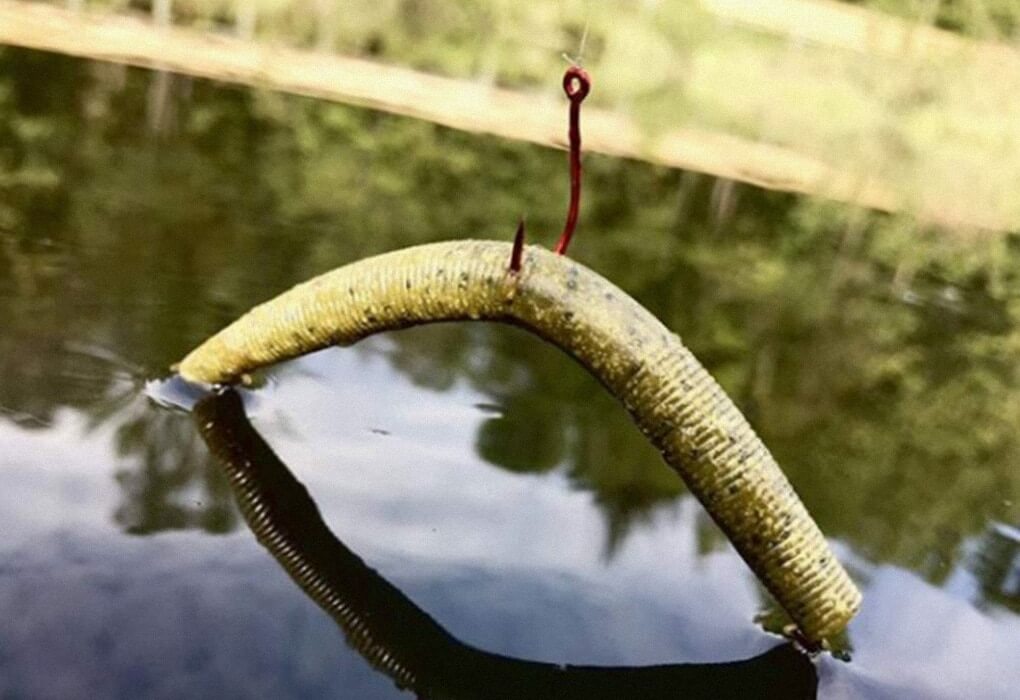
The best-kept secret in fishing isn’t really a secret at all – it’s sitting right there in the bargain bin at your local tackle shop. While trophy catches often get credited to expensive crankbaits and swimbaits, many of the most successful anglers I know fill their livewells using simple soft plastics.
These affordable, rubber-textured lures come in endless shapes to match virtually any prey. From worms to lizards to baitfish profiles, they’re incredibly versatile and forgiving to fish.
I especially love how they excel in different situations – rigging a beaver bait for punching thick cover, swimming a paddletail through open water, or bouncing a craw along rocky bottom.
The real magic happens when you match the right profile to local forage. By paying attention to what the fish are feeding on and choosing a similar soft plastic with the right action, you can often outfish more expensive baits. It’s not about how much you spend – it’s about making that bait look alive.
Craws are another excellent option for smallmouth, particularly when used as jig trailers.
Target fish keep a keen eye out for the clawed appendages and narrow bodies of crawdads in the mud, so the key is imitating their jerk-pause-jerk movements.
Buzzbaits
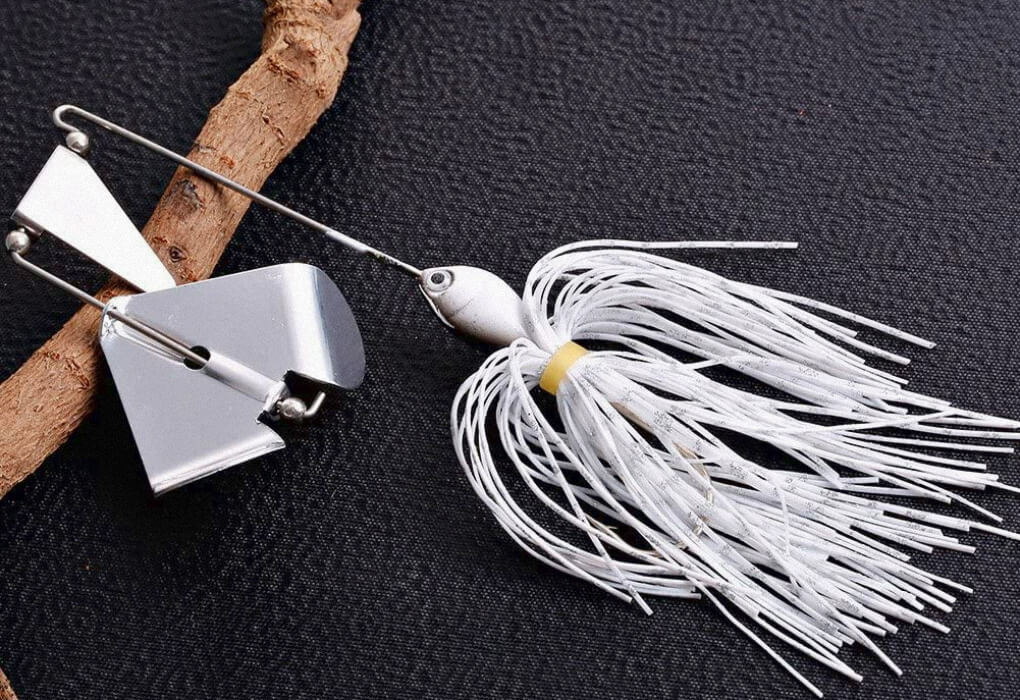
Heart-pounding surface strikes are what fishing dreams are made of. But timing those explosive topwater bites can be tricky – reel too fast and fish miss the bait, too slow and you lose that enticing action. The difference between success and frustration often comes down to understanding the subtle details of your presentation.
This is where buzzbaits really stand out. With their unique combination of squealing blade and silicone skirt, these lures create the perfect storm of sound and disturbance that triggers reaction strikes.
I’ve found the wire frame design with its weighted head keeps the bait tracking true, while that metal blade up top churns up just the right amount of commotion.
You’ll need to be quick on the retrieve with buzzbaits to get the bubbles and blade going.
Once it surfaces, slow down your retrieve and gently jerk the fishing line to create more dynamic movement. Continue drawing it back and prepare for a fight once the fish breaches the surface.
Bass seem to avoid fully engulfing buzzbaits, but that doesn’t make them ineffective. You just have to give the fish a chance to chomp down and embed the hook before you retrieve your line.
Cast out, as usual, get the lure to the surface, then reel in slow and steady. When you feel the strike, give the fish a second to latch on before you try to set the hook.
Once you feel the weight, you can start reeling harder.
Trailers are also helpful for tempting the fish to bite instead of swiping at these types of fishing lures.
Spinnerbaits
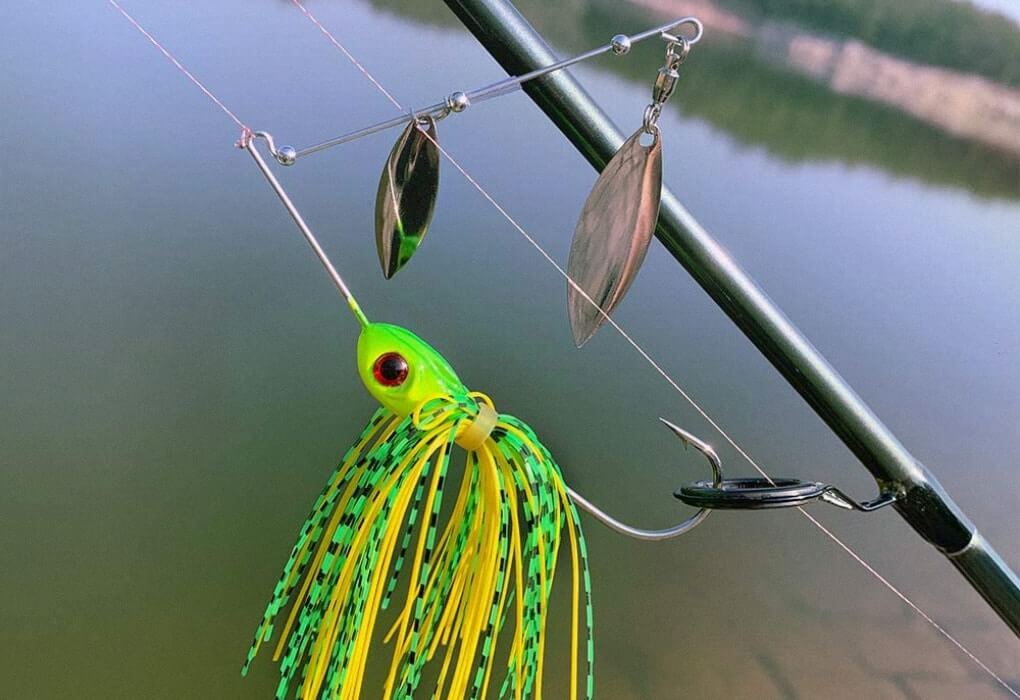
Light, vibration, and movement – bass are hardwired to respond to all three. But trying to present these triggers separately often leads to missed opportunities. What if you could combine them into one irresistible package that works in almost any condition?
That’s exactly what makes spinnerbaits so deadly effective. By combining a fish-shaped weighted head, flashing blades, and a pulsing silicone skirt, they create a perfect storm of attraction.
I’ve found this unique design excels at triggering both reaction strikes and actively feeding fish, making it one of the most versatile search baits in my box.
Success with spinnerbaits comes down to understanding how to match them to conditions. I’ll pop my rod tip on the initial drop to get those blades turning and creating vibration. In clear water on sunny days, silver blades create that perfect flash, while gold and copper work better in stained water.
Just keep them away from heavy weeds – once those blades get tangled, you’ll spend more time cleaning than fishing. When the conditions are right, few lures can match a spinnerbait’s ability to cover water and trigger strikes.
Chatterbaits
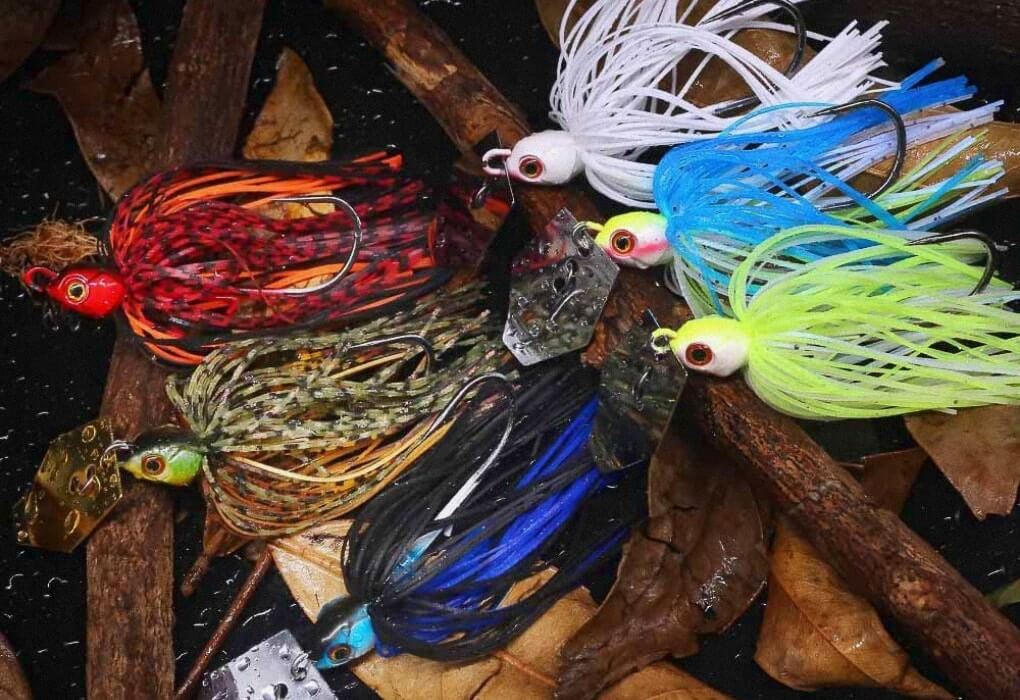
When fish aren’t reacting to traditional baits, sometimes you need to shake things up – literally. Most anglers reach for their trusty spinnerbaits when the bite gets tough, but there’s a relatively new player in the game that’s changing how we think about reaction strikes.
Enter the chatterbait, with its distinctive hexagonal blade that creates a totally different kind of vibration in the water. Unlike traditional spinnerbaits, this design produces an aggressive side-to-side wobble that I’ve found triggers strikes even in the toughest conditions.
The combination of that unique blade and silicone skirt creates a multisensory attraction that fish simply can’t ignore.
What really sets chatterbaits apart is their versatility. I can work them through dense weeds where spinnerbaits get hung up, bounce them along the bottom to mimic crawfish, or swim them steadily through muddy water where that intense vibration calls fish from a distance.
They’re especially deadly around shallow docks in spring when bass are looking for an easy meal. When traditional reaction baits aren’t getting it done, that distinctive chatter is often just what it takes to trigger strikes from inactive fish.
Frogs

Nothing beats watching a bass explode through a mat of lily pads to crush your lure. While many anglers avoid heavy cover, thinking it’s too difficult to fish, they’re missing out on some of the most exciting strikes in fishing. The real magic happens when you can reach those untouched spots other lures can’t touch.
That’s why I always keep frogs ready in my tackle box. Whether you choose a rigid or soft body design, these weedless wonders slip through the nastiest cover with ease.
The simple construction, often enhanced with silicone legs for extra action, is perfectly designed for creating that irresistible surface disturbance that triggers explosive strikes.
The presentation is beautifully simple – let it splash down, pause briefly, then work it slowly across the surface. I love how they allow me to target areas most anglers pass by, like thick vegetation and lily pad fields.
When a big bass decides to crash through that cover to attack your frog, it’s the kind of heart-stopping moment that creates fishing memories that last a lifetime.
Jerkbaits
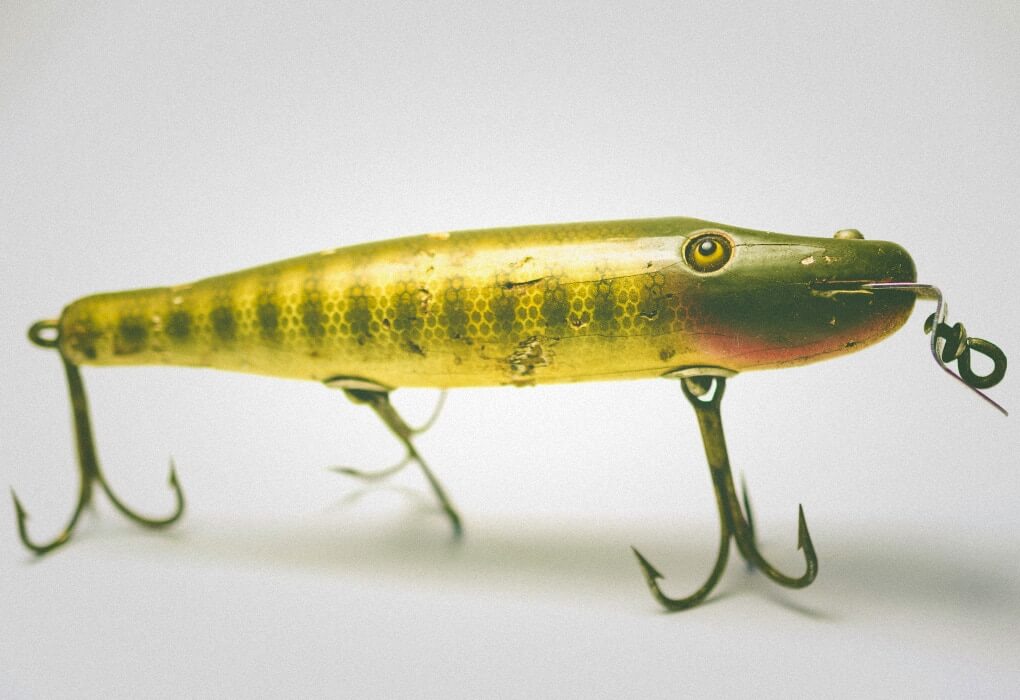
When fish seem to follow your lure forever without committing, sometimes you need to trigger their predatory instinct. Most anglers make the mistake of retrieving too steadily, when what’s often needed is a presentation that screams “easy meal.” The difference between follows and strikes often comes down to making your bait look vulnerable.
This is where jerkbaits truly excel. Whether floating, suspending, or sinking, these minnow-shaped lures perfectly mimic an injured baitfish when worked properly. I’ve found that mastering the cadence is crucial – a snap-snap-pause retrieve creates that erratic, wounded action that predatory fish simply can’t resist.
The real beauty of jerkbaits lies in their versatility. I work them with my rod tip to create those darting movements, letting them pause and flutter just like a struggling baitfish. They’re especially deadly for suspended bass, hanging in the strike zone and drawing fish up from deeper water.
When conventional retrieves aren’t getting it done, that wounded baitfish presentation often triggers those reaction strikes we’re all after.
Swimbaits
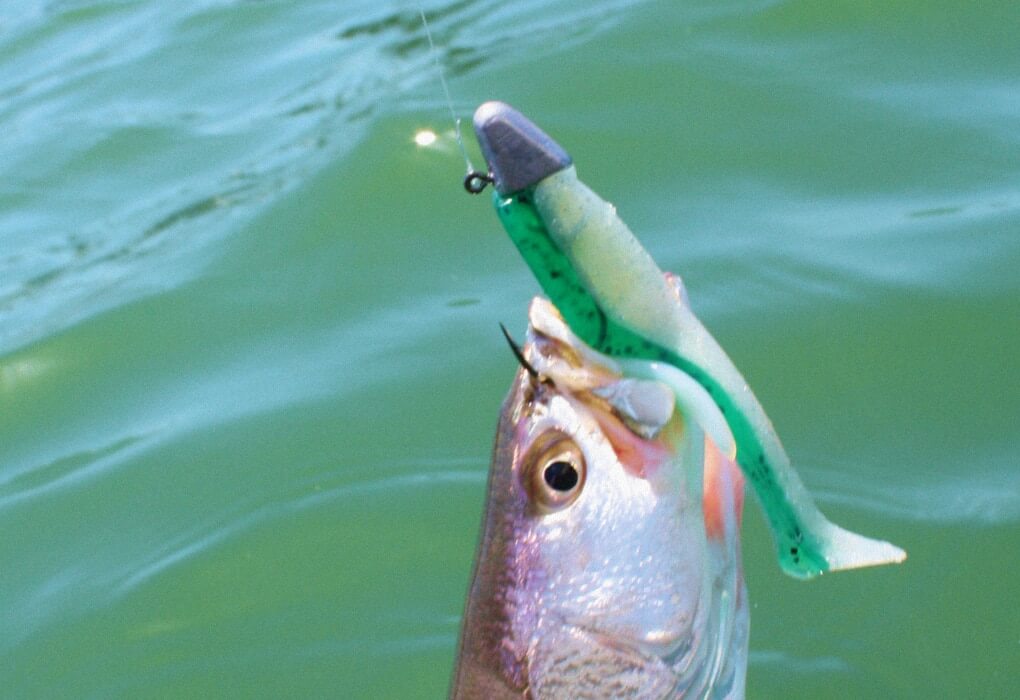
Big fish eat big baits – but it’s not quite that simple. While many anglers throw oversized lures hoping for trophy catches, they often come home empty-handed. The secret isn’t just about size – it’s about creating a presentation so realistic that even wary trophy fish can’t resist.
That’s where swimbaits shine. Available in hard-bodied, soft-bodied, and hybrid designs, these lures are meticulously crafted to mimic local forage like bluegill, shad, and trout.
I particularly love how soft-body versions create that natural swimming rhythm that feels authentic when a fish strikes. While hard-body versions with their jointed design excel in open water, they can be challenging around heavy cover.
Success with swimbaits requires patience and precision. I focus on making each retrieve look as natural as possible rather than covering water quickly. While they might lack the flash and vibration of other lures, their realistic appearance and action is often what it takes to fool those trophy fish that have seen it all.
In clear water where fish can get a good look, few lures can match a swimbait’s ability to trigger strikes from big, cautious fish.
Stickbaits
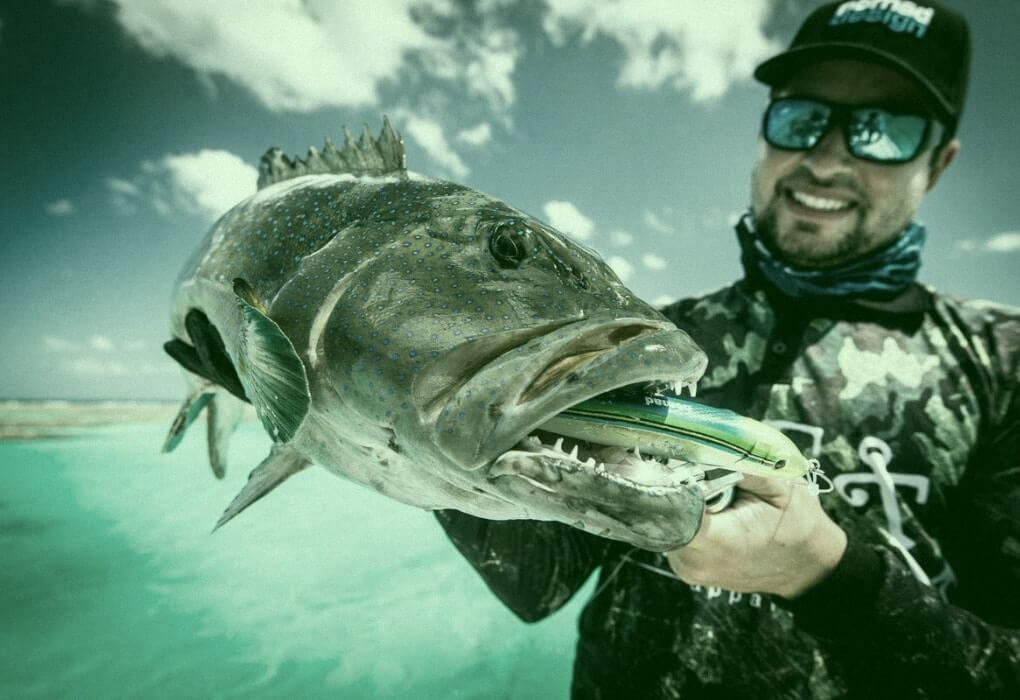
The smallest details often make the biggest difference in fishing. While many anglers focus on fancy features and wild colors, sometimes the most basic profile – when presented correctly – is all you need. The challenge is knowing how to make that simple design come alive in the water.
This is where stickbaits have earned their reputation as fish-catching machines. These slim, minnow-like lures might look basic, but their versatile design can mimic a wide range of baitfish behaviors. Whether equipped with bills, rattles, joints, or subtle color patterns, I’ve found their effectiveness comes down to understanding the forage they’re imitating.
The key is keeping them in motion naturally. I like to mix up my retrieves with subtle jerks and pauses, especially around cover where baitfish would naturally seek shelter.
In clear, calm water, rattling versions really shine – that combination of realistic profile and subtle sound often triggers strikes when nothing else will. By matching your presentation to the behavior of local baitfish, these simple-looking lures can produce remarkable results.
Crankbaits

Most fish have two triggers that consistently produce strikes – sound and deflection. While most lures focus on one or the other, some anglers overlook the category that excels at both. The challenge is knowing how to match the right style and diving depth to where fish are holding.
That’s why I rely heavily on crankbaits. Whether you choose a lipped version with its diving bill or a lipless model with internal rattles, these lures excel at triggering reaction strikes. I especially love how lipped cranks deflect off cover on the retrieve, while lipless versions create that irresistible rattling that draws strikes even in stained water.
The secret is matching the diving depth to your target zone. I keep shallow, medium, and deep-diving versions ready, letting me effectively work different layers of the water column.
When I’m covering water quickly for active fish, few lures can match a crankbait’s ability to trigger those aggressive reaction strikes. By bouncing them off cover and varying your retrieve speed, you can turn a slow day into consistent action.
Topwater Poppers
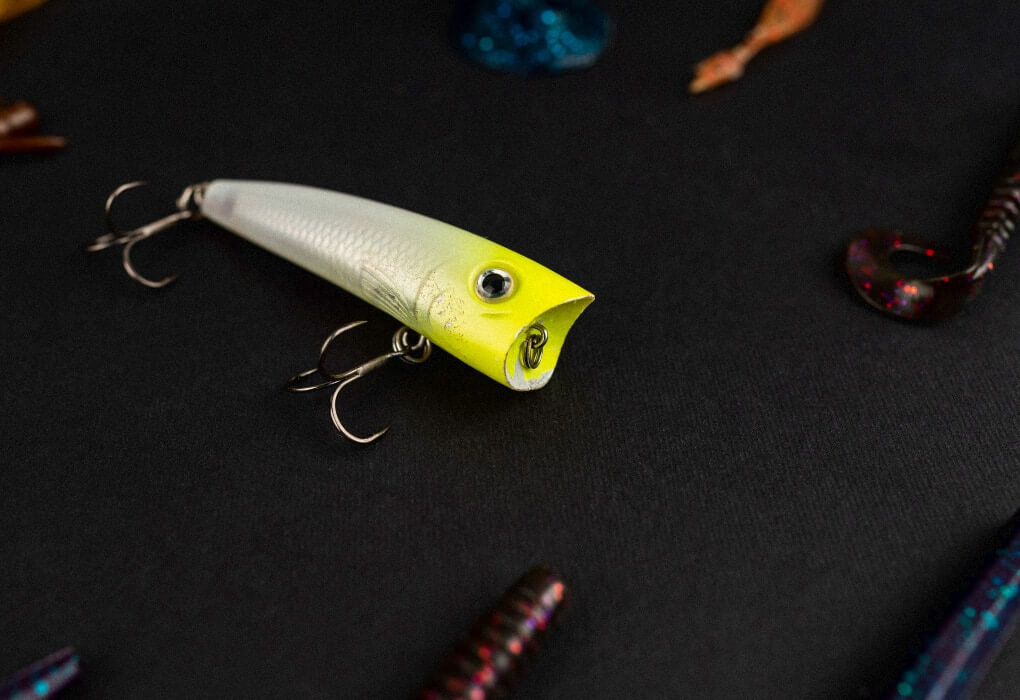
The most addictive moments in fishing happen when you can actually see the strike coming. While many anglers get caught up in complex deep-water techniques, they’re missing out on the pure excitement of surface fishing. The real thrill comes from watching a bass track your lure before exploding on it.
That’s what makes topwater poppers so special. With their concave mouths designed to spit, pop, and chug across the surface, they create the perfect commotion to draw attention from below.
I love how they give you options – aggressive chuggers for those times when you need maximum noise and disturbance, or more subtle spitters when fish want a finesse presentation.
The presentation is both simple and exciting. I work them around the edges of cover, using a slow, steady cadence on calm days or a more aggressive pop-and-pause when fish are active. Color choice is crucial – I go bright in murky water and darker in clear conditions to create the perfect silhouette.
While their treble hooks mean you need to be careful around heavy cover, the visual excitement of topwater strikes makes poppers one of the most satisfying ways to catch fish.
Spoons
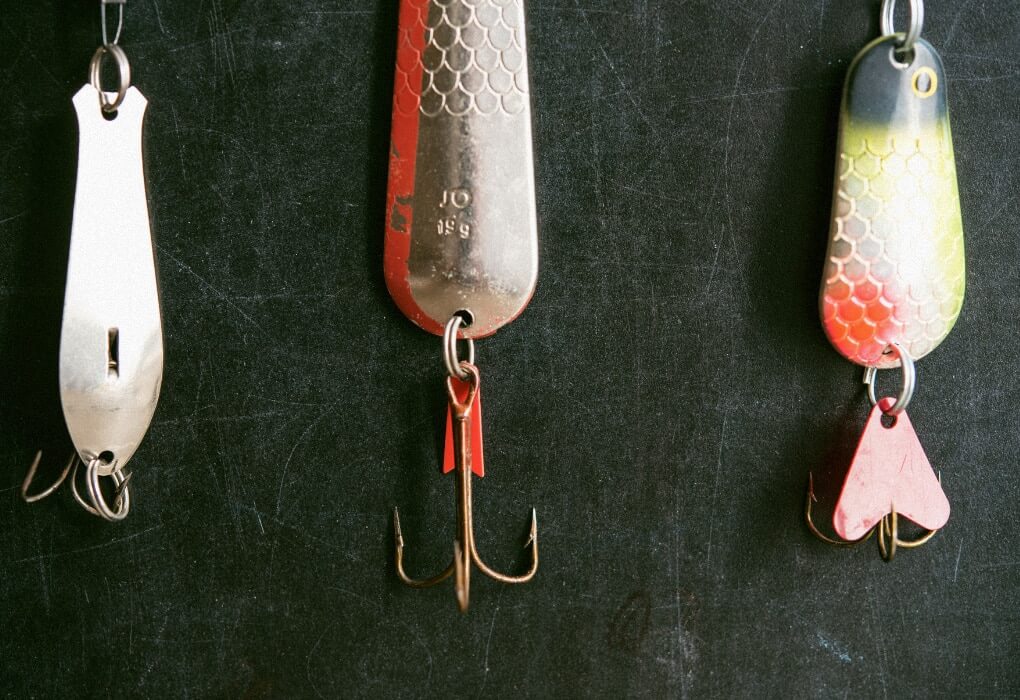
Flash and flutter – sometimes the oldest tricks are still the best ones. Long before fancy hard baits and soft plastics, anglers discovered that a simple piece of curved metal could trigger strikes better than anything else. The secret lies in its ability to mimic the most vulnerable moment in a baitfish’s life.
That’s why spoons have stayed relevant for over a century. Their concave, chrome-plated design creates that irresistible wounded-baitfish action, throwing off flashes of light just like the scales of a struggling minnow. I’ve found this combination of flash and erratic movement often triggers strikes when nothing else will.
The beauty of spoons lies in their versatility. I’ll add weight to get them down deep in the strike zone, or work them on the surface where that flash imitates baitfish bellies. Working them with a pump-and-pause retrieve in flat areas really lets them show off that classic flutter.
While they might seem simple compared to modern lures, that basic design still produces strikes just like it did generations ago.
Final Thoughts
For covering all types of water, I consistently reach for noisy topwater lures in heavy cover and subtle soft plastics when fishing clear water. This combination produces strikes in almost any condition.
When the bite gets tough, I’ll often downsize to more finesse presentations like tubes or small jigs – sometimes a more subtle approach is all it takes to trigger those reluctant biters.
Want to dial in exactly which lure types are working best in your local waters? Drop a comment below with your favorite fishing spots and the conditions you’re dealing with. I’ll share some specific techniques that have worked for me in similar situations.
I check these comments daily and love helping fellow anglers expand their lure selection and presentation skills!




